A Puzzle for my Town
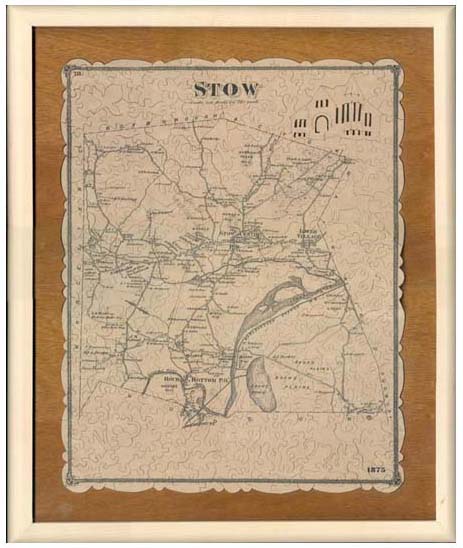 The town of Stow has a rich, quiet heritage that I have enjoyed for 23 years.
I felt a special wooden jigsaw puzzle was something lasting I could contribute to
he town that would capture some of that history and heritage. Donating it to the
Randall Library seemed appropriate since it houses a wonderful display of our heritage
and is a place of contemplation and learning for young and old alike. I hope children
enjoy seeing the puzzle and learning about the figural pieces and that adults enjoy seeing the work of art.
The town of Stow has a rich, quiet heritage that I have enjoyed for 23 years.
I felt a special wooden jigsaw puzzle was something lasting I could contribute to
he town that would capture some of that history and heritage. Donating it to the
Randall Library seemed appropriate since it houses a wonderful display of our heritage
and is a place of contemplation and learning for young and old alike. I hope children
enjoy seeing the puzzle and learning about the figural pieces and that adults enjoy seeing the work of art.
I chose a reproduction of an antique map of Stow to give the puzzle an historical theme. The irregular
edge is suggestive of an antique border and the figurals, specially shaped puzzle pieces, capture items and
events from the town’s inception until the present. There are 16 special pieces.
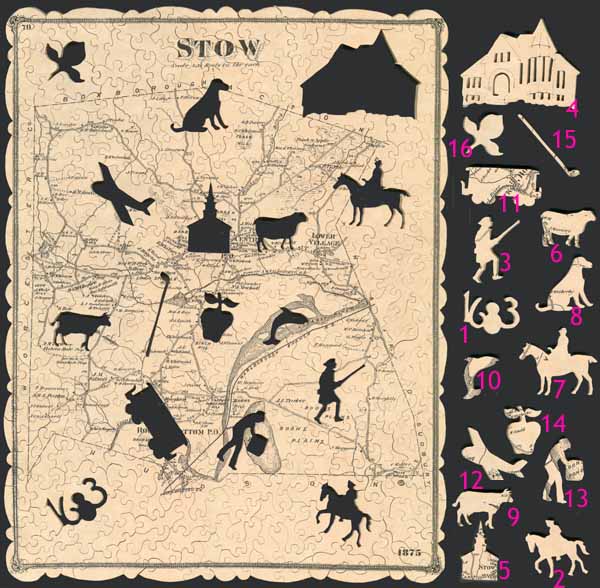
Our beginnings.
- 1. The year the town was incorporated, 1683
- 2. Minute men who marched or rode to Concord in the 1700’s
- 3. The second Minute man symbolizes what is actively reenacted every Patriot’s day as we keep our history alive.
Historical Buildings
- 4. Our library. This figural is the most complex of all the figurals. It took over 4 hours from inception to completion. The figural was traced from a picture of the original Randal Library. Accent lines were cut to depict curves and windows its architecture. There are 19 windows and a curved archway less than a 32nd of an inch wide. There are other cuts to emphasize the cupola, the steps and the overhangs and indentations of the building. In addition to the outline, the figure required 10 independent drill cuts to complete.
- 5. The Stow First Parrish Church. Of the four churches in Stow, this is the oldest. While space did not permit every figural to be placed where it might belong on the map, I placed this in the center of town to symbolize that faith is a center of our community.
Animals central to Stow life.
- 6. Sheep are probably our most famous animal. In the past it’s wool supplied our mills and today is has a special place at Pilot Grove farm. The sheep in the puzzle is near the farm.
- 7. Horses are the next most prominent animal. There are many farms that feature riding and many summers saw the Horse Shows at Carver Hill. The equestrian rider waits her turn in the show.
- 8. Recent noteworthy animals of Stow were the hearing aid dogs of Red Acre Farm. The dog in the puzzle has a special accent-cut to show his ears.
- 9. A cow heading for milking. There were many dairy farm in Stow, in fact, my house on Circuit Drive was once part of a pasture.
- 10. The Assabet River flows through Stow. To the native Americans, assabet meant “place of fishes”.* There is a fish jumping for bugs where the Assabet runs.
Transportation and Industry
- 11. At the turn of the century, a trolley served as transportation from Maynard through Stow to Hudson. The trolley in the picture is heading for Hudson on Route 62.
- 12. A plane represents our local airport.
- 13. Until the late 1930’s Ice was an important industry. On Boon’s Pond, now Lake Boon, a man harvests a 2 foot square of ice from the lake.
- 14. Stow has at least four apple orchards today and they are all delicious (apples that is!).
- 15. Our town also has, not one, not two, not three, but four golf courses. A golf club is placed where Stow Acres and Butternut Golf course are located today.
My signature piece
- 16. The last figural is a stylized iris that has two meanings. For Stow, it represents our Garden Club whose efforts are seen year round in the town. For the puzzle, puzzle cutters have a signature piece that they put in their puzzles that is signed, dated and numbered on the back to authenticate and identify their work. My signature piece is the stylized iris. I have signed and dated it when the cutting was complete on 4/18 2002 and “numbered” it with the inscription “to Randall Library”
The puzzle is 10 ¼ inches wide by 13 ¼ inches high and contains 305 pieces.
Each piece was hand cut on a scroll saw using very thin blade. The blades measure 8/1000’s of an
inch wide and 12/1000’s of an inch long, or the size of two horse hairs. These thin blades enable me
to cut the fine work required for the figural pieces and give the puzzle a very tight interlock. From
a distance, you may not be able to see where the cuts are and this puzzle interlocks so tightly it can be
picked up by a corner!
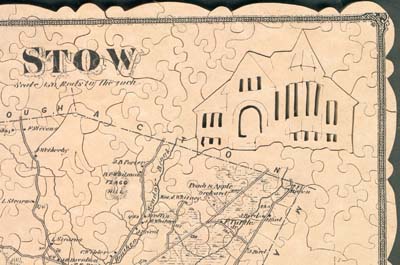
Different cutting styles give puzzles different looks. Most modern, die-cut, cardboard puzzles are cut with what is called a strip cut where knobs and holes are cut in stripes first vertically then horizontally and give the image a blocky look. Hand cut puzzles are quite often done in different styles of the cutters. The cutting style I chose for the puzzle I call “curls and knobs”. The effect of the cutting style is smooth and flowing. It is pleasant to look at, and yet difficult to assemble.
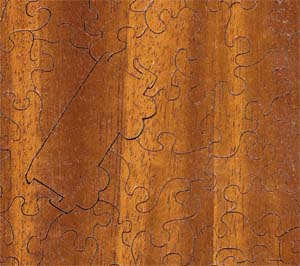
The puzzle was made of ¼ inch mahogany plywood. The wood is a special grade and must be perfect on both front and back and all interior layers. After the puzzle is cut, it is assembled, sanded, and hand-finished with multiple coats of Tung Oil and Shellac. The finish brings out the beauty of the wood and gives the pieces a nice, smooth feel. The back of the puzzle is as nice to look at as the front.
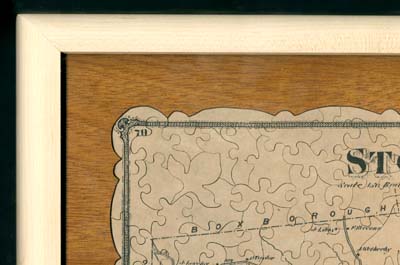
The puzzle sits in a hand-finished wooden tray, also of mahogany plywood. The tray and puzzle outline were cut simultaneously from the same piece so that the puzzle fits exactly
in the tray. The frame, made from contrasting maple, is my special design. The puzzle can be securely hung, but when the frame is flat, it allows quick, easy access to the puzzle
for assembly.
Melinda Shebell
Founder and Owner of Jardin Puzzles 
4/24/2002
|


 The town of Stow has a rich, quiet heritage that I have enjoyed for 23 years.
I felt a special wooden jigsaw puzzle was something lasting I could contribute to
he town that would capture some of that history and heritage. Donating it to the
Randall Library seemed appropriate since it houses a wonderful display of our heritage
and is a place of contemplation and learning for young and old alike. I hope children
enjoy seeing the puzzle and learning about the figural pieces and that adults enjoy seeing the work of art.
The town of Stow has a rich, quiet heritage that I have enjoyed for 23 years.
I felt a special wooden jigsaw puzzle was something lasting I could contribute to
he town that would capture some of that history and heritage. Donating it to the
Randall Library seemed appropriate since it houses a wonderful display of our heritage
and is a place of contemplation and learning for young and old alike. I hope children
enjoy seeing the puzzle and learning about the figural pieces and that adults enjoy seeing the work of art.








